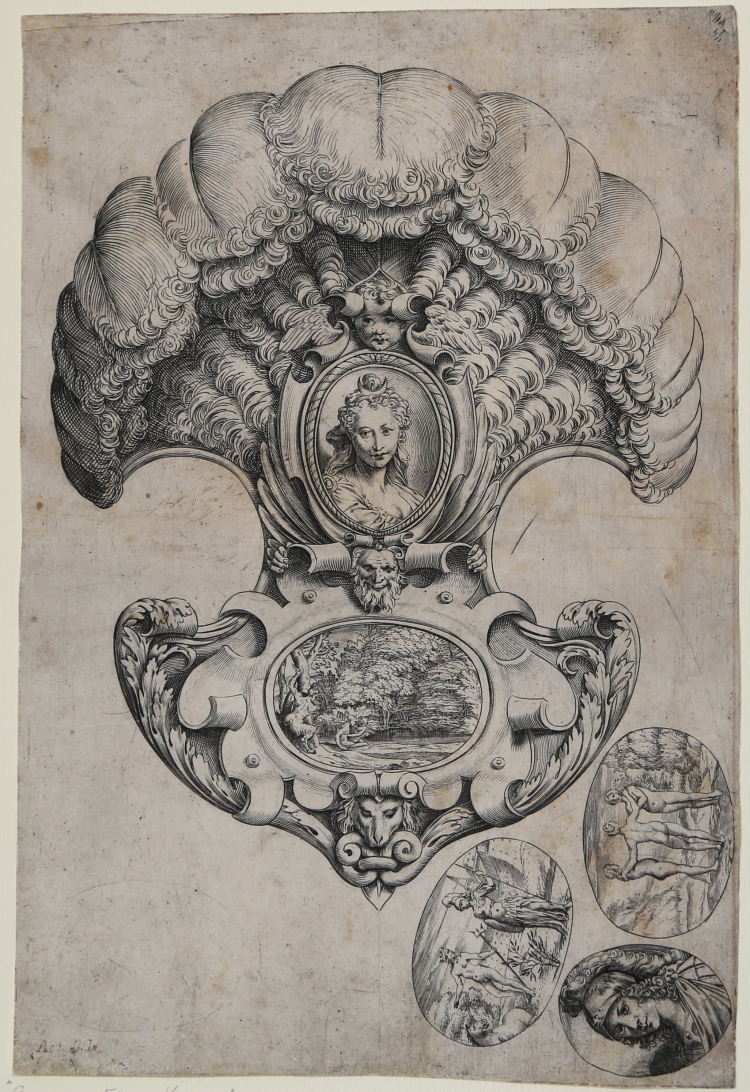



| Reference: | S28900 |
| Author | Agostino CARRACI |
| Year: | 1589 ca. |
| Measures: | 251 x 368 mm |


| Reference: | S28900 |
| Author | Agostino CARRACI |
| Year: | 1589 ca. |
| Measures: | 251 x 368 mm |
A headpiece in the form of a fan; sheet containing a design in the shape of a feathered fan, with two oval frames in centre, one containing a portrait of Diana and the other a landscape with a satyr and two nymphs, with grotesque masks above and below; at lower right of the sheet three further ovals, one containing a portrait of Minerva, one of the Three Graces and a third of Minerva and Neptune.
Engraving, about 1589-95, signed on plate at bottom left (second state only).
Example in the rare first state of two, before letters.
Magnificent proof, rich tone, printed on contemporary laid paper without watermark, trimmed to the copperplate, restoration carried out perfectly in the white top, traces of glue on verso, otherwise in excellent condition.
De Grazia writes "The engraving has always been interpreted as a representation of a fan, but it must be something else, because the fan does not have the handle and one in the center is too cumbersome to allow such use. There is no explanation of the three ovals in the lower right corner, and a fourth just mentioned a lower left. Diane Russell suggested that perhaps the object was intended as a cap to cut out and bring in a party. In this way each scene in the ovals could be alternated with pleasure at the bust and the landscape of the hat".
If this was his destination likely to be realized in 1589 on the occasion of the wedding of Ferdinando de 'Medici and Christine of Lorraine.
Example of the first state are absolutely rare.
Bibliografia
De Grazia, Le Stampe dei Carracci, pp. 178/9, 193 I/II; Bartsch 260.
Agostino CARRACI (Bologna 1557 - Parma 1602)
|
Leading figure of the “Accademia degli Incamminati”, started in Bologna by his uncle, Lodovico Carracci, Agostino supported the anti-mannerism movement. He wanted to restore the great Italian tradition of the Renaissance, referring to artists such as Titian, Raphael, Michelangelo and Correggio.
Unlike Lodovico and Annibale, who preferred paintings and frescoes, he devouted himself to engravings, which he considered more coherent with his nature, reaching a very high quality level for the brightness of his sign and his technical skills.
He visited Parma, Venice and Rome (1594) following his brother Annibale who had been hired by the Farnese family, and this helped him to enlarge his knowledge of contemporary engravings.
His catalogue of engravings includes 234 pieces, with sacred subjects, taken from the main artists of his time (Tintoretto, Barocci, his brother Annibale, Francesco Vanni and many others); profane subjects, which he particularily loved and in which it can be seen his deep love for old, classic arts.
|
Agostino CARRACI (Bologna 1557 - Parma 1602)
|
Leading figure of the “Accademia degli Incamminati”, started in Bologna by his uncle, Lodovico Carracci, Agostino supported the anti-mannerism movement. He wanted to restore the great Italian tradition of the Renaissance, referring to artists such as Titian, Raphael, Michelangelo and Correggio.
Unlike Lodovico and Annibale, who preferred paintings and frescoes, he devouted himself to engravings, which he considered more coherent with his nature, reaching a very high quality level for the brightness of his sign and his technical skills.
He visited Parma, Venice and Rome (1594) following his brother Annibale who had been hired by the Farnese family, and this helped him to enlarge his knowledge of contemporary engravings.
His catalogue of engravings includes 234 pieces, with sacred subjects, taken from the main artists of his time (Tintoretto, Barocci, his brother Annibale, Francesco Vanni and many others); profane subjects, which he particularily loved and in which it can be seen his deep love for old, classic arts.
|